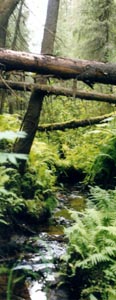
Ecology of the old-growth forests ecosystems
Ancient forest maintains fundamental ecological processes associated with natural (gap-dynamic)
and ancient semi-natural (fire dynamic) forces, and is of sufficient size to allow these mechanisms to function.
These forests are further characterized by specific features, which distinguish them from other
"mature" and "over-mature" forests:
- · Natural patterns of age-distribution (ie: uneven-aged canopy and unsynchronized stands
and trees growth and development) which are fundamental to sustained ecosystem function;
- · High levels structural and microclimate diversity, which are fundamental to maintaining
a high level of natural biodiversity;
- · Continued balance of all main indicators of forest ecosystem function (including absorption
and release of carbon dioxide, growth rate and turnover of tree biomass, appearance and
decomposition of dead wood etc.)
What is so important about the ancient forests.
The remaining ancient forests in the European North of Russia appear to be unique natural
complexes with a key significance in conservation of environmental balance in northern regions.
The most important characteristics of these areas are considered to be the following:
- These are the only areas in which it is feasible to conserve a range of natural ecosystems,
the functioning of which is fully dependent on larger areas of adjoining territories
(this includes an overwhelming majority of river and lake ecosystems, numerous boggy and bedder
ecosystems). In turn such ecosystems are fundamental to the conservation of the huge and
complex biodiversity which they currently support. The present forestry system, which promotes
the conservation of only minor fragments of natural areas, is doomed to lead to ecosystem
degradation, even where existing watersheds are protected.
- It is only within ancient forests that it is feasible to conserve self-sustaining ecosystem functions,
including the activities of phytophagans (unequivocally considered by forestry as "pests") and of tree
fungi (regarded by forestry as "diseases") as well as blowdowns, snowbreaks and other natural disorders.
- Extensive ancient forests in the European North appear to be the only territories which
provide an opportunity to guarantee natural conservation of populations of many major animal
species whose living requires vast areas (bears, wolves, reindeer, numerous birds).
- Only major areas exceeding 1 million ha are able to provide real protection of a representative
"wilderness" area, which can guarantee conservation not only of entire biological and ecosystem
diversity, but also of natural evolutionary processes.
- Major areas of ancient forests with no settlements or transport networks - and thus having
protection from most fire origins - serve as proven reservoirs of carbon dioxide, and hence key
regulators of the climate. Boggy ecosystems occurring within these areas also appear to provide
reliable absorbers of carbon dioxide.
- It is only in major areas of ancient forests, that local populations of the Russian North are
able to conserve their traditional subsistence activities, associated with hunting, fishing and
consuming other non-timber products of forest, since their supplies within the so-called "developed"
Northern area have already been virtually destroyed.
Back to Old-growth page
|





